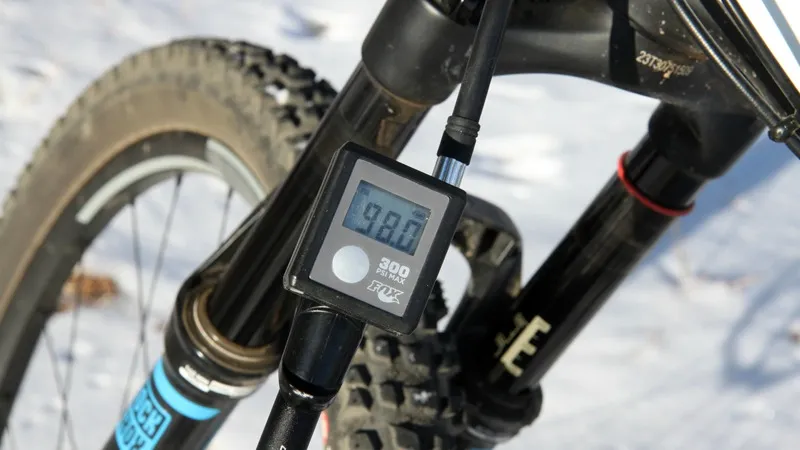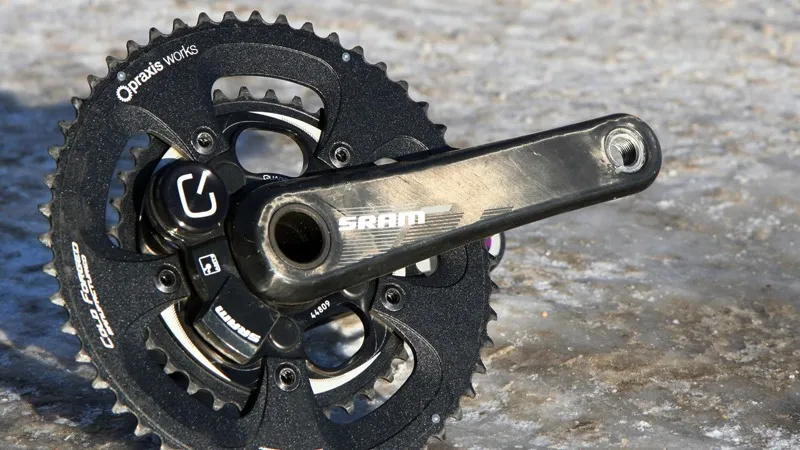Figuring out how to keep your body warm in cold and wet conditions is always tricky, but keep in mind that your bike undergoes changes in those temperatures, too. Here are some pointers on what you can do to get your machine ready to face Old Man Winter.
- Winter cycling survival guide
- 11 tips to keep you riding in cold, wet conditions
- Best mudguards: a buyer's guide
1. Go wide and soft
There are few materials whose properties are more drastically affected by a huge downward swing in temperature than your tires — specifically, the rubber that so tenuously grips the road or trail. Whereas in more reasonable conditions your tread might willfully conform to the ground and keep you upright, it will harden up in ultra-cold temperatures and leave you wanting for traction right when you need it the most.
Many tire companies publish the specific Shore durometers of the rubber compounds used in the tread. Higher numbers indicate a harder compound and usually, companies go with a medium option so as to balance grip, durability, and rolling resistance. If you plan on regularly heading out this winter, consider switching to tires with a softer compound than what you'd normally run for a little extra traction.

Specialized tire guru Wolf VormWalde also advocates going with a tire built with a synthetic, not natural, rubber compound.
"Below 7°C, the temperature has noticeable negative effects on rubber compounds that are designed around natural rubber," he said. "The compound becomes harder, less flexible and adjusts less to the ground. A softer natural rubber, carbon-filled compound is preferable to a harder natural rubber compound. The natural rubber compound still hardens more than a comparable synthetic silica compound with a higher glass transition temperature would."
Also think about switching to a wider tire than you'd normally run. This serves the same goal of boosting traction, but in this case by increasing the size of the contact patch.
The ultimate bargain solution, however, is to simply decrease your tire pressure.
2. Lighten up — your hub lube, that is
Rear hubs can be particularly susceptible to jamming up in cold temperatures if the lubricants inside get too thick, which can lead to problems like skipping under power or chainsuck. While the lubricants inside the freehub body thicken with decreasing temperature, the pawl springs unfortunately don't automatically make the same type of adjustment.
If your current hubs perform beautifully during the summer but act up when it's cold, that's a good sign that you should change things up. Try a thinner grease than usual or even switch to oil depending on your particular make and model.

It's best to check with the manufacturer if they have specific recommendations, though. Chris King, for example, recommends switching from its usual RingDrive grease to 10w-30 motor oil to maintain proper function.
3. Ease into it
It seems logical that it's better to store your bike indoors where it's warm and dry than out in the bitter cold — and in my experience, that still holds true. However, I've also found that it isn't always best to take that warm and happy bike straight out into the cold.
One trick I learned while living in the US Midwest (where an above-freezing winter forecast was solid justification for cracking out the shorts) was to let my bike 'pre-chill' to ambient temperatures before heading out on my ride. As a result, any snow that was tossed up by the tires would hit a similarly frigid frame and quickly fall off, as opposed to melting on impact, only to slowly refreeze and pack up.
This won't help during 'in-between' temperatures when there's liquid water on the road that somehow manages to freeze instantly to anything on impact but otherwise, it's always helped me in the past.
4. Tweak the squish
Mountain bike suspension components are affected by very cold temperatures, too, and the settings that feel so perfect during the summer might seem completely off during the winter. Oil thickens, air pressure decreases, and friction increases between sliding parts. Taken in total, this can make your forks and shocks feel both overly soft and uncomfortably harsh at the same time.
"Temperature has so much effect on the bike, it’s amazing," says Fox race program manager Mark Fitzsimmons. "The first thing a consumer should do is double check their air pressure and set sag or pump up the fork/shock to their summer pressures. Next would be to open up compression and rebound a couple of clicks. But keep in mind, if the temperatures of the dampers increase on longer, rougher descents, damping will become faster. The same goes for if the outside temperature increases throughout the ride."

Riders should also keep in mind the internal layout of their particular components, too. A fork with an open-bath damper, for example, will tend to have more oil volume than a fork with a fully sealed cartridge damper and isn't likely to heat up as much during a ride due to friction.
5. Tune up the power
Mechanical components aren't the only thing you need to think about before heading out into the cold. Riders who train with power meters should also consider how temperature changes affect data. Chances are that if you've got a power meter on your bike, you probably also keep it indoors.
Depending on the actual temperatures outside, that means your bike could potentially go through a huge swing in just a few minutes that could drastically change the accuracy of your meter. Stages Cycling claims its power meter automatically compensates for ambient temperature changes, but owners of just about every other direct-measurement power meter on the market should take notice.

According to Mike Hall of SRM, the most important thing is to make sure that your power meter is the same temperature as the outside.
"For those of us who are keeping our bikes indoors, at room temperature, the offset value of the power meter will change when going outside," he said. "It's best to ride for around ten minutes before setting the zero offset.
"Another tip is clean the power meter after really nasty, slushy rides on roads where salt and/or magnesium chloride is used. Leaving the road grime on the outside of the power meter will (over time) degrade the anodizing of the aluminum. Keeping equipment cleaned after use is a good rule of thumb in any season."
6. Fix it — or freeze it
Finally, think about the tools and spares you typically bring with you. Can you operate everything with gloves on? Tools with tiny little pieces and interchangeable bits will not only be tough to use with gloved fingers but you can only imagine what would happen if you dropped a critical piece into the snow.

Save the ultralight and compact multi-tools for race day and instead consider using something bigger and chunkier that's easier to use.
Are you a seasoned winter rider with tips of your own? Feel free to share in the comments section below.